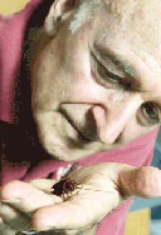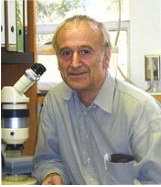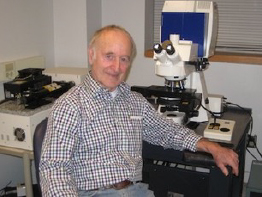Lab Faculty

Lab Head/Principal Investigator
Professor L.J. Zwiebel
Cornelius Vanderbilt Chair
Department of Biological Sciences and Pharmacology
LJ. Zwiebel is a native New Yorker and received his undergraduate (B.S) degree in Biochemistry from the State University of New York at Stony Brook whilst doing bacteriology research under Drs. Martin Freundlich and Masayori Inouye. He completed a M.S. degree in Biology at the University of Michigan working with Dr. Gordon Moore and his Ph.D. in Molecular Genetics from Brandeis University working on the role of the period gene in circadian rhythms under Drs. Jeffery Hall and Michael Rosbash both of who subsequently received the Nobel Prize in Medicine (2017) for their work on biological rhythms.
After completing his PhD, Dr. Zwiebel studied molecular genetics of medfly transformation and mosquito olfaction as a postdoctoral fellow with Dr. Fotis C. Kafatos at Harvard University, The Institute for Molecular Biology and Biotechnology in Heraklion, Crete (Greece) and The European Molecular Biology Laboratory in Heidelberg, Germany. He joined the faculty of Vanderbilt University as an Assistant Professor of Biology in January 1998 and has since been appointed as Associate Professor and thereafter, Professor of Biological Sciences, Professor of Pharmacology as well as being named the Cornelius Vanderbilt Chair of Biological Sciences in 2012.
Dr. Zwiebel’s academic research at Vanderbilt focuses upon the molecular and neurological characterization of behavioral processes that impact host (i.e. blood-meal source) seeking and selection in disease vector mosquitoes. The lab examines the molecular events of olfaction (smell) as this sense predominates the overall host preference behaviors in mosquitoes and other insects and as such makes a significant contribution to the vectorial capacity of these mosquitoes. Knowledge from these studies will be used to adapt new approaches for modifying mosquito behaviors-specifically the strong attraction to humans. In addition to several federally funded research projects, Dr. Zwiebel was the lead investigator of an international network of laboratories that was selected for a Grand Challenge in Global Health (GCGH) award from the Bill and Melinda Gates Foundation for the specific purpose of using state of the art molecular approaches to design a new generation of mosquito repellents and attractants. The Zwiebel Lab also studies the role of olfaction in mediating the complex behaviors of eusocial ants, which use cuticular hydrocarbon (CHCs) pheromones to mediate social behaviors such as aggression, caste and nestmate recognition, as well as the regulation of reproduction and neuronal plasticity. These findings open the possibility of studying using ants as a model system to examine the genetics of sociality as it relates to humans and other animals.
Beyond his research and teaching activities Dr. Zwiebel is actively pursuing the development of next-generation insect repellents using a novel suite of Vanderbilt University Allosteric Agonists (VUAAs) that were discovered during his GCGH project. These novel actives broadly disrupt the behaviors of mosquitoes and, indeed, all insects, thereby rendering these compounds as potential next-generation insect excito-repellents. As part of the GCGH/Grand Challenge Exploration program, the laboratory has reduced VUAA activity to a suite of active volatiles, significantly potentiating their utility as both personal and spatial repellents. The development of products based on VUAA actives has recently been taken on via OrcoGuard, a startup company in the quest to deliver next-generation insect excito-insect repellents into practice across a wide range of formulations.
Dr. Zwiebel also serves on several advisory and review panels for the US National Institutes of Health, The National Science Foundation, The Bill and Melinda Gates Foundation, The Institut Pasteur, The Max Planck Society, The Wellcome Trust and The World Health Organization. He also acts as an advocate for Public Health/Vector Biology/Global Health issues via numerous national and international speaking engagements and teaching venues.



Professor Dr. H. Willi Honegger
Research Professor, Retired, 2016-
Research Professor, Department of Biological Sciences, Vanderbilt University 2005-2015
Professor, Department of Biological Sciences, Vanderbilt University 1995-2005.
Professor, Technical University, Munich, Germany, 1982-1995
Research Interests:
My continuous research interest has been focused on how insect behavior is controlled by the nervous system. Since 1995 I directed the research of my group entirely on the molecular identification of the neurohormone bursicon. Since it regulates the hardening of the cuticle of freshly ecdysed insects it was clear that revealing its molecular identity and its receptor would clarify its broader functional role and might potentially provide effective tools for insect control. My group, in collaboration with others, finally succeeded in identifying bursicon and its receptor, published in Current Biology and PNAS in 2004 and 2005 respectively. Our findings, in turn, have triggered the identification of new functions as well as the insight into the high sequence conservation of bursicon among arthropods. Importantly, it is clear now that bursicon also regulates wing inflation and maturation in adults. Upon closing my own research group in 2005 Larry Zwiebel invited me to join this powerful group. Since then I have been involved in interactions and advisory activities to explore further functions of bursicon and other neuropeptides as well as a variety of collaborative projects with colleagues in the Department of Biological Sciences and beyond.
Selected Publications on Bursicon and other Subjects:
Neuronal odor coding in the larval sensory cone of Anopheles coluzzii: Complex responses from a simple system. Sun H, Liu F, Baker AP, Honegger HW, Raiser G, Zwiebel LJ. Cell Rep. 2021 Aug 17;36(7):109555. doi: 10.1016/j.celrep.2021.109555. PMID: 34407405
Bünning Remembered. Honegger HW, Hemleben V, Mayer WE, Engelmann W. J Biol Rhythms. 2020 Feb;35(1):6-15. doi: 10.1177/0748730419900028. Epub 2020 Jan 21.
An alternative pathway to eusociality: Exploring the molecular and functional basis of fortress defense. Lawson SP, Sigle LT, Lind AL, Legan AW, Mezzanotte JN, Honegger HW, Abbot P. Evolution. 2017 Aug;71(8):1986-1998. doi: 10.1111/evo.13285. Epub 2017 Jun 30.
Cardioacceleratory function of the neurohormone CCAP in the mosquito Anopheles gambiae. Estévez-Lao TY, Boyce DS, Honegger HW, Hillyer JF. J Exp Biol. 2013 Feb 15;216(Pt 4):601-13. doi: 10.1242/jeb.077164.
Bursicon-expressing neurons undergo apoptosis after adult ecdysis in the mosquito Anopheles gambiae. Honegger HW, Estévez-Lao TY, Hillyer JF. J Insect Physiol. 2011 Jul;57(7):1017-22. doi: 10.1016/j.jinsphys.2011.04.019. Epub 2011 May 1.
Two peptide transmitters co-packaged in a single neurosecretory vesicle. Woodruff EA 3rd, Broadie K, Honegger HW. Peptides. 2008 Dec;29(12):2276-80. doi: 10.1016/j.peptides.2008.08.023. Epub 2008 Sep 20.
Bursicon functions within the Drosophila CNS to modulate wing expansion behavior, hormone secretion, and cell death. Peabody NC, Diao F, Luan H, Wang H, Dewey EM, Honegger HW, White BH. J Neurosci. 2008 Dec 31;28(53):14379-91. doi: 10.1523/JNEUROSCI.2842-08.2008.
Identification, developmental expression, and functions of bursicon in the tobacco hawkmoth, Manduca sexta. Dai L, Dewey EM, Zitnan D, Luo CW, Honegger HW, Adams ME. J Comp Neurol. 2008 Feb 10;506(5):759-74. doi: 10.1002/cne.21575.
Bursicon, the tanning hormone of insects: recent advances following the discovery of its molecular identity. Honegger HW, Dewey EM, Ewer J. J Comp Physiol A Neuroethol Sens Neural Behav Physiol. 2008 Dec;194(12):989-1005. doi: 10.1007/s00359-008-0386-3. Epub 2008 Nov 13.
The bursicon gene in mosquitoes: an unusual example of mRNA trans-splicing. Robertson HM, Navik JA, Walden KK, Honegger HW. Genetics. 2007 Jun;176(2):1351-3. doi: 10.1534/genetics.107.070938. Epub 2007 Apr 15.
Bursicon, the insect cuticle-hardening hormone, is a heterodimeric cystine knot protein that activates G protein-coupled receptor LGR2. Luo CW, Dewey EM, Sudo S, Ewer J, Hsu SY, Honegger HW, Hsueh AJ. Proc Natl Acad Sci U S A. 2005 Feb 22;102(8):2820-5. doi: 10.1073/pnas.0409916102. Epub 2005
From bioassays to Drosophila genetics: strategies for characterizing an essential insect neurohormone, bursicon. Honegger HW, Dewey EM, Kostron B. Acta Biol Hung. 2004;55(1-4):91-102. doi: 10.1556/ABiol.55.2004.1-4.11.
Identification of the gene encoding bursicon, an insect neuropeptide responsible for cuticle sclerotization and wing spreading. Dewey EM, McNabb SL, Ewer J, Kuo GR, Takanishi CL, Truman JW, Honegger HW. Curr Biol. 2004 Jul 13;14(13):1208-13. doi: 10.1016/j.cub.2004.06.051.
Cellular localization of bursicon using antisera against partial peptide sequences of this insect cuticle-sclerotizing neurohormone. Honegger HW, Market D, Pierce LA, Dewey EM, Kostron B, Wilson M, Choi D, Klukas KA, Mesce KA. J Comp Neurol. 2002 Oct 14;452(2):163-77. doi: 10.1002/cne.10357.
Antisera against Periplaneta americana Cu,Zn-superoxide dismutase (SOD): separation of the neurohormone bursicon from SOD, and immunodetection of SOD in the central nervous system. Kostron B, Market D, Kellermann J, Carter CE, Honegger HW. Insect Biochem Mol Biol. 1999 Oct;29(10):861-71. doi: 10.1016/s0965-1748(99)00060-0.
Antibodies against the PER protein of Drosophila label neurons in the optic lobe, central brain, and thoracic ganglia of the crickets Teleogryllus commodus and Teleogryllus oceanicus. Lupien M, Marshall S, Leser W, Pollack GS, Honegger HW. Cell Tissue Res. 2003 Jun;312(3):377-91. doi: 10.1007/s00441-003-0720-6. Epub 2003 May 23.
Physiological characterisation of antennal mechanosensory descending interneurons in an insect (Gryllus bimaculatus, Gryllus campestris) brain. Gebhardt M, Honegger HW. J Exp Biol. 2001 Jul;204(Pt 13):2265-75.
Glutamate-like immunoreactivity marks compartments of the mushroom bodies in the brain of the cricket. Schürmann FW, Ottersen OP, Honegger HW. J Comp Neurol. 2000 Mar 6;418(2):227-39.
Impact of motor activity and antennal mechanosensory input on the intensity of proctolin-like immunoreactivity in antennal motoneurons of crickets (Gryllus bimaculatus). Bartos and H.W. Honegger (1997) Journal of Comparative Physiology A 181, pages 59–70.